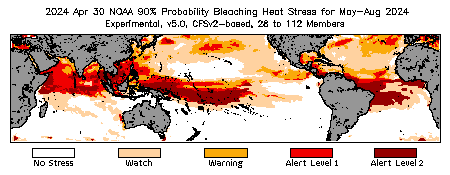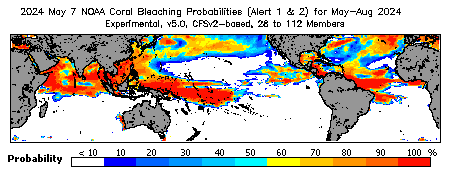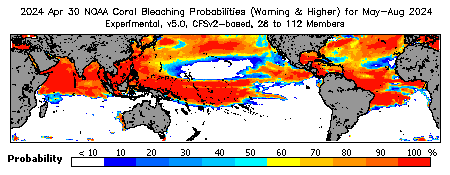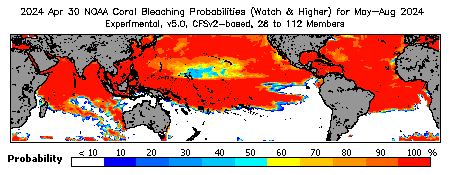(Version 5, released on 27 March 2018, updated weekly)
| Outlook of Coral Bleaching Heat Stress: | (Click on the images below to see them in full-size.) |
| 90% Chance:
(Stress level predicted by 90% of ensemble members) |

|
Weekly Outlook |
| 60% Chance:
(Stress level predicted by 60% of ensemble members) |

|
Weekly Outlook |
| Probabilistic Outlook of Bleaching Heat Stress Reaching and Exceeding Specified Levels: |
|
Alert Level 2: |

|
Weekly Outlook |
|
Alert Levels 1 & 2: |

|
Weekly Outlook |
|
Warning & higher: |

|
Weekly Outlook |
|
Watch & higher: |

|
Weekly Outlook |
| |
NetCDF4 Data: HTTPS FTP | Pixel Images: HTTPS FTP |
| Product Metadata: | Web-format Metadata | XML Metadata | Plain Text Metadata |
The NOAA Coral Reef Watch (CRW) experimental weekly Four-Month Coral Bleaching Outlook product at 0.5°x0.5° spatial resolution presented here is version (5.0). It was made available on November 21, 2017 and released publicly on the CRW website on March 27, 2018. The Outlook is updated weekly, usually on early Tuesday afternoon (U.S. Eastern Time), and is based on the daily sea surface temperature (SST) forecast from the NOAA/National Weather Service National Centers for Environmental Prediction's (NCEP) Climate Forecast System Version 2 (CFSv2). CFS is an operational, dynamical, fully coupled ocean-land-atmosphere seasonal climate forecast model system. CRW's CFS-based Bleaching Outlook is detailed in Eakin et al. (2012) and Liu et al. (2018).
CRW's CFS-based Outlook predicts the likelihood of coral bleaching heat stress up to four months in the future (typical length of a bleaching season). Four-month composite outlook maps of six variables are displayed on this page. Outlooks of the six variables that predict potential heat stress conditions for each week during the target four-month period, and that the four-month composite outlooks are derived from, are accessible through the "Weekly Outlook" links provided to the right of the corresponding composite maps. The CFSv2 provides 16 forecast runs per day (nine 45-day forecast runs, three 90-day forecast runs, and four 9-month forecast runs). From these, CRW constructs between 28 and 112 ensemble members at a weekly time scale for its probabilistic outlooks. 112 members are included for future Weeks 1-5, 49 members for Weeks 6-12, and 28 members for Weeks 13-36, with Week 1 being the first future week predicted. The Outlook is updated weekly, on Tuesday.
The relationship between the predicted heat stress and potential bleaching severity is based on CRW's heritage heat stress levels (which extended to Bleaching Alert Level 2 only) for the daily global 5km satellite coral Bleaching Alert Area product, as follows:
|
Stress Level
|
|
|
|
|
|
Weekly Outlooks, incorporating model runs from Weeks 2-15 and often up to Week 20, were used in deriving the Four-Month Coral Bleaching Outlook.
Note about the Outlook netCDF data file names:
Sunday's date is used to identify a week, in each week of the Four-Month Outlook period. So, as an example,
if the netCDF data file name is:
cfsv2_outlook-060perc_4mon-and-wkly_v5_icwk20240714_for_20240728to20241027.nc ,
then icwk20240714 (a Sunday) indicates the model's initial condition week (July 8-14, 2024); 20240728 indicates the Sunday of the first week (in the future) that is being predicted in the Four-Month Outlook; and 20241027 indicates the Sunday of the last week that is being predicted in the Four-Month Outlook. Since the Outlook is updated every Tuesday (which is two days after the initial condition week), the first week to be predicted is the week after that Tuesday. In this example, the Four-Month Outlook would have been updated on 20240716 (a Tuesday), based on the initial conditions from the week of 20240714 (or July 8-14, 2024). So, the first week that the Outlook is predicting ends on 20240728. Also of note, the second date in the netCDF data file name is always two weeks after the first date in the file name; the third date is always the last Sunday of the fourth month after the month indicated in the second date.
Note that CRW's Four-Month Coral Bleaching Outlook was formerly known as the Seasonal Coral Bleaching Heat Stress Outlook. Although the product does provide the maximum composite outlook for the entire coverage period of four months, it also provides an outlook for each individual week within a four-month period. Furthermore, the product updates weekly, not seasonally as the previous name might suggest.
In a normal year, the Outlook forecasts no potential for bleaching. When the forecasted SST exceeds bleaching thresholds over a long enough period to cause bleaching, the Outlook maps display the bleaching potential. Actual conditions may vary due to model uncertainty, subsequent changes in climatic conditions, extreme localized variability, or weather patterns.
The 90% and 60% Chance global maps at the top of the page show the heat stress level predicted by 90% and 60%, respectively, of the model ensemble members used. Taking the 90% Chance map as an example, at any given data grid, the individual stress levels predicted by all ensemble members are ranked based on the severity of predicted stress for each future week predicted, from the lowest level to the highest. The highest ranking 90% of the members are then selected. The lowest stress level predicted by the highest ranking ensemble members is the heat stress level displayed in the 90% Chance map. In other words, at least one of the ensemble members in the highest ranking 90% predicted the stress level shown; others may have predicted the same or higher stress, if any. Model ensemble members of the remaining 10% predicted either the displayed stress level or lower, if any. At any data grid, the chance for heat stress that is higher than what is indicated in the map is less than 90% and can even be zero.
Users are referred to the probabilistic maps (the bottom four maps on this page) for the chance of any particular stress range (Bleaching Watch and higher, Bleaching Warning and higher, Alert Levels 1 and 2, and Alert Level 2) occurring across the globe over the next four months. Each map displays the percentage of the ensemble members that predicted heat stress within the range specified. For instance, if a data grid shows 70% for the map of Warning & Higher, it indicates that 70% of the ensemble members predicted Warning, Alert Level 1, and/or Alert Level 2, and any two of these three levels may not have been predicted at all.
Due to limitations in model physical processes, numerical calculations, initializations, and inherent unpredictability of the climate system, the accuracy of forecasts depends significantly on geographic location and forecast lead-time. For the same geophysical location, the forecast accuracy decreases with increasing lead-time.
In general, a model performs better for regions where the processes are controlled by large scale variations; for example, the central-eastern tropical Pacific Ocean, the central-eastern tropical Indian Ocean, and the Caribbean. The skill is relatively high even for longer lead-times in these regions when large-scale climate signals, such as El Niño Southern Oscillation (ENSO), prevail. Ensembles (repeated runs of the model using slightly different initial conditions) used in probabilistic forecasts help to increase the chance of capturing the reality among a set of possible future climate patterns generated.
Assessment of the skill of CFSv2 SST forecast, upon which CRW's Coral Bleaching Outlooks are based, is available here.
While acknowledging potential model limitations, longer lead-time predictions are helpful in preparing coral reef stakeholders to understand potential future heat stress. They can greatly support effective reef management and conservation decisions and communication with the public and local decision makers. NOAA CRW suggests caution, however, in the use and analysis of outlooks with lead-times longer than 20 weeks.
CRW's very first (pioneer) weekly Four-Month Coral Bleaching Outlook was at 2°x2° spatial resolution and was released to the public in July 2008 during the 11th International Coral Reef Symposium. It was based on the SST forecast from an experimental, statistical Linear Inverse Modeling (LIM) system (Liu et al. 2009). The LIM-based Outlook was discontinued in February 2015 due to issues discovered with the LIM model's forecast for specific coral reef areas around the globe.
The first version of CRW's CFS-based probabilistic weekly Four-Month Coral Bleaching Outlook, based on the SST forecast from CFS Version 1 (CFSv1, Saha et a. 2006), was released to the public in July 2012 during the 12th International Coral Reef Symposium (Eakin et al., 2012). The CFS-based Outlook has significantly enhanced CRW's capability for predicting the likelihood of coral bleaching heat stress. With CFS' multiple forecast runs per day, CRW is able to produce a probabilistic outlook that was not possible with CRW's former, LIM-based deterministic Outlook. In this very first version of the probabilistic CFS-based forecast, the Outlook was based on 28 ensemble members derived from CFS' four 270-day forecast runs per day, over a week.
In December 2012, the second version of the CFS-based weekly Four-Month Coral Bleaching Outlook was released by upgrading the system to use the SST forecast from the operational CFSv2 (Saha et al. 2012; Saha et al. 2010) that replaced CFSv1 (Liu et al. 2018). In February 2015, the third version of the CFS-based Outlook was launched with a finer spatial resolution of 0.5x0.5-degrees, increased from the previous 1x1-degree resolution (Liu et al. 2018). Furthermore, the daily 0.25-degree Optimum Interpolation SST (OISST) Version 2 analysis was used to provide the observations that fed the Outlook Version 3.0 product, instead of the weekly 1x1-degree OISST Version 2. As a result, the Outlook Version 3.0 for a predicted time period was produced one week earlier than the Outlook Version 2.0.
In the Outlook Version 4.0, released publicly in May 2017, all 16 daily forecast runs available from the CFSv2 were used to construct significantly more ensemble members for the first 12 weeks of the four-month probabilistic forecast (Liu et al. 2017, 2018). All other aspects of the forecast system remained the same as in the Outlook Version 3.0.
The most recent Outlook Version 5.0 (v5) was made available in November 2017 and released publicly in March 2018. For this version, CRW's near-real-time daily 5km satellite Coral Bleaching HotSpot Version 3 replaced the daily Coral Bleaching HotSpot derived from the daily 0.25-degree OISST Version 2 analysis as the observational feed. This enhanced the continuity between CRW's satellite nowcast and modeled forecast of bleaching heat stress for the upcoming weeks and months.
In the Outlook v5, a seven-day period of linear transition from the last observed daily satellite HotSpot (used in the calculation) to the predicted HotSpots is carried out for each model run separately. This provides a smooth transition from the satellite observed "truth" to the modeled predictions. To be consistent with our satellite algorithm where the 7-day maximum Bleaching Alert Area composite is used to identify bleaching heat stress in near-real-time, in the Outlook v5, for each model run, the weekly maximum is derived from the daily Bleaching Alert Area for each week, for each data grid, and is then used to generate weekly and four-month probabilistic predictions. In previous Outlook versions, the weekly Bleaching Alert Area median was employed. To the maximum extent possible, shifting from using the weekly median to the weekly maximum Bleaching Alert Area only introduces three additional days of stress accumulation for any given week. During the period of active stress accumulation, using the weekly maximum to represent a week's stress simply makes the higher stress appear one week earlier, as compared with using the weekly median because the maximum stress level of any week is the minimum level of the following week. If a week falls on the last week of a predicted four-month time period, the stress predicted by the Outlook v5 would appear higher than earlier product versions for the same four-month time period. However, this does not mean the Outlook v5 is overestimating the level of heat stress; rather that it is revealing the presence of stress in the week when it occurs. All other aspects of the forecast system remain intact.
This effort is made possible through collaboration between NOAA's NCEP and CRW, with funding support from NOAA's NCEP, Climate Program Office, and Coral Reef Conservation Program.
Your feedback is important for us to improve our products. Please send your comments and suggestions to coralreefwatch@noaa.gov.
References
Eakin CM, Liu G, Chen M, Kumar A (2012) Ghost of bleaching future: Seasonal Outlooks from
NOAA's Operational Climate Forecast System. Proc 12th Int Coral Reef Sym.
ICRS2012_10A_1.
Liu, G, Eakin CM, Chen M, Kumar A, De La Cour JL, Heron SF, Geiger EF, Skirving WJ, Tirak KV,
Strong AE (2018) Predicting Heat Stress to Inform Reef Management: NOAA Coral Reef Watch's
4-Month Coral Bleaching Outlook. Front. Mar. Sci. 5:57.
doi: 10.3389/fmars.2018.00057.
Liu, G, Skirving WJ, Geiger EF, De La Cour JL, Marsh BL, Heron SF, Tirak KV, Strong AE, Eakin CM (2017)
NOAA Coral Reef Watch's 5km Satellite Coral Bleaching Heat Stress Monitoring Product Suite Version 3
and Four-Month Outlook Version 4. Reef Encounter
45 32(1): 39-45..
Saha S, Moorthi S, Wu X, Wang J, Nadiga S, Patrick T, Pan H, Behringer D, Hou Y, Chuang H,
Iredell M, Ek M, Meng J, Yang R, van den Dool H, Zhang Q, Wang W, Chen M (2012) The NCEP
Climate Forecast System Version 2. Submitted to the
Journal of Climate.
Saha S, Moorthi S, Pan H, Wu X, Wang J, Nadiga S, Tripp P, Kistler R, Woollen J, Behringer
D, Liu H, Stokes D, Grumbine R, Gayno G, Wang J, Hou Y, Chuang H, Juang H, Sela J, Iredell M,
Treadon R, Kleist D, Van Delst P, Keyser D, Derber J, Ek M, Meng J, Wei H, Yang R, Lord S,
van den Dool H, Kumar A, Wang W, Long C, Chelliah M, Xue Y, Huang B, Schemm J, Wesl ey Ebisuzaki,
Lin R, Xie P, Chen M, Zhou S, Higgins W, Zou C, Liu Q, Chen Y, Han Y, Cucurull L, Reynolds RW,
Rutledge G, Goldberg M (2010) The NCEP Climate Forecast System Reanalysis.
Bull. Amer. Meteor. Soc., 1015-1057.
doi: 10.1175/2010BAMS3001.1.
Saha S, Nadiga S, Thiaw C, Wang J, Wang W, et al. (2006) The NCEP Climate Forecast System.
J. Climate 19: 3483-3517.